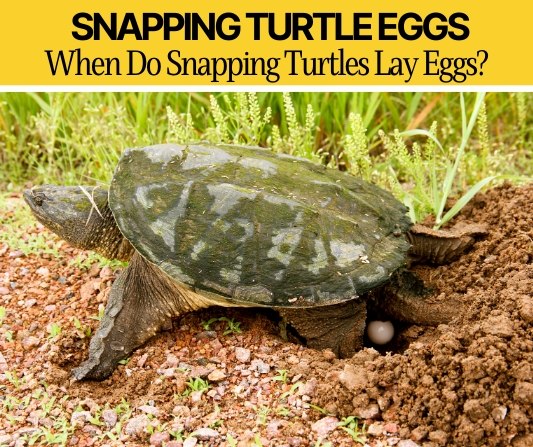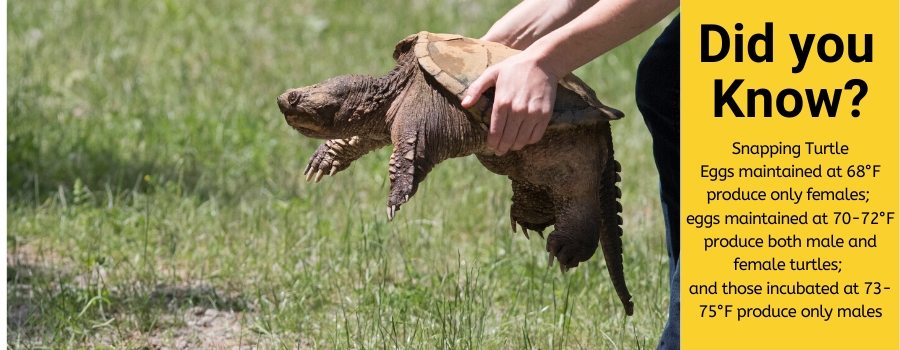 Snapping turtles are so at home in the water that they actually hibernate in ponds in the winter, sometimes not breathing fresh air for months at a time.
Snapping turtles are so at home in the water that they actually hibernate in ponds in the winter, sometimes not breathing fresh air for months at a time.
Given their love for their aquatic homes, it seems improbable that anything will drive them onto land. One thing will though: the urge to produce offspring.
Snapping turtles, year after year, trudge onto land and make their painstakingly slow way from their watery homes to dig a nest and lay their eggs.
So when does this phenomenon occur?
When Do Snapping Turtles Lay Eggs?
Snapping turtles usually lay eggs during the warmer months of the year and can technically nest anytime during the day and night. Still, they do have a favorite time of day to nest. Most studies seem to indicate their preferred nesting times are in the morning and the evening. One study showed that colder summers may result in more turtles laying eggs in the evening rather than morning.
Being cold-blooded creatures, turtle nesting times also seem to be dependent on how cold it is. If the temperature drops too low, their body temperature will as well and they will not be able to nest.
What Time of Year Do Snapping Turtles Lay Their Eggs?
In general, the time of year snapping turtles lay their eggs is during the warmer months, ranging all the way from April to November. However, the specific months in each part of the continent can vary significantly. On average, May and June seem to be the most common months for snapping turtles to lay eggs.
The start of the nesting season is also dependent on the temperatures of the earlier months of March through May. In general, the cooler the spring months are, the later nesting season begins. Again, being cold-blooded animals, snapping turtles have to wait for warm enough weather to begin the nesting season.

Where Do Snapping Turtles Lay Eggs
Snapping turtles lay their soft, round eggs in holes shaped like a vase. They may dig their nests—called clutches—on the bank of a body of water or even up to a mile or so away from any water source.
With some of their natural habitat shrinking, it’s now not uncommon to find mother turtles wandering into people’s yards and freshly dug gardens to bury their eggs. Turtle Rescue League recommends just letting the mother turtle do her business and leaving her alone. Although you may watch this fascinating process from a safe distance, keep animals and children away from her. Remember, snapping turtles have long flexible necks and can snap off a finger quite easily. But don’t worry. You’ll have to wait for only a couple of hours at most. Then, once the mother is done burying her eggs, she’ll go back to her pond and won’t return.
Do Snapping Turtles Lay Eggs in the Same Place Every Year
Snapping turtles do seem to lay eggs in the same place every year, but only after they have found a nesting place they like, which could take several years. Scientists have speculated what makes a good nesting site for snapping turtles. Some theories include that the turtles may choose a nesting site because it is similar to one they emerged from. Or perhaps because the environment is similar to one that they spent time in as a young hatchling or a juvenile turtle. On the other hand, they may also decide to return to the exact same nesting site they were born from, just like sea turtles do.
Do Snapping Turtles Lay Eggs in Water
Although snapping turtles love the water and spend most of their life in it, they do not lay eggs in water. The reason for this is that the baby turtles growing inside the eggs need access to a minimum supply of oxygen which passes through their shell even under the ground. If they are covered in water, they will die. They also need stable temperatures and cannot be rotated, unlike bird eggs. Still, even though being buried on land is crucial for their survival as eggs, once those baby turtles have hatched, they head straight for water and will remain there for the vast majority of their lives.
How Deep Do Snapping Turtles Bury Eggs
A snapping turtle’s clutch seems to range from around fourteen to twenty-five centimeters deep, and the depth seems to be correlated to the size of the female turtle. This makes sense since her flippers are going to determine how deep she is able to dig her nest.
How Many Eggs Do Snapping Turtles Lay
The female snapping turtle may lay anywhere from around twenty to eighty eggs in a clutch. Unlike their sea turtle cousins, female snapping turtles lay just one clutch per year but they tend to nest almost every year. The exact range of how many eggs a turtle may lay varies according to the size of the mother. There have even been reports of up to one hundred eggs in a single clutch dug by extra large female turtles.
Like other reptiles, the sex of the baby turtles correlates to the temperature of the clutch. Temperatures of 23-27 ℃ will produce males, slightly above and below will produce both sexes, and more extreme temperatures will produce females.
Gestation Period for Snapping Turtle Eggs
The gestation period for snapping turtle eggs is usually around ninety days. The mating season may begin around spring once turtles have emerged from their winter hibernation. If females lay their eggs from around May though June, hatchlings will emerge from their nests in the fall with September being the peak time for snapping turtle eggs to hatch.
How Long Do Snapping Turtle Eggs Stay in the Ground Till Eggs Hatch?
Snapping turtle eggs remain in the ground around ninety days before they hatch. However, this number may range from around seventy to over a hundred days. The hatchlings could all emerge on the same day or over a period of a couple of days.
How Big Are Baby Snapping Turtles When They Hatch?
When they first emerge from digging out of their natal nest, snapping turtles are very small—only around two or three centimeters in length or roughly the length of a quarter. This tiny turtle is a far cry from the up to 19-inch adult it will grow up to be.
Interestingly enough though, the turtles can vary in size according to where they were located in the clutch. The young turtles whose eggs were close to the top of the nest usually end up being smaller than their siblings further down. Scientists have studied hatchlings’ body size to determine if there is a correlation between size and the turtle’s ability to survive. It turns out that bigger is not always better and there doesn’t seem to be a connection between how large a baby snapping turtle is and its chance of survival. No matter their size, baby snapping turtles have a pretty grim mortality rate. Some estimate that the chance of a hatchling making it to its first year of adulthood is around 22%.
On average, snapping turtles generally lay eggs during the months of May and June, usually in the evening or morning. After roughly ninety days incubating in the ground, the young hatchlings emerge around September. Although the mother turtle will never see either her eggs or her young again, we can protect these fascinating creatures by leaving them alone when we see them nesting. It won’t take long for the mother to finish, and it is a fascinating process to watch.
Other Snapping Turtle Questions:
Do Snapping Turtles Guard Their Eggs and Come Back for Them?
No, like most other species of reptiles besides crocodiles, snapping turtles do not guard their eggs and come back for them. After the female turtle does the difficult work of digging and burying her eggs, her maternal responsibilities are over. She leaves the clutch and does not return.
Even though the mother turtle takes some precautions in protecting her eggs by disguising the nest, this doesn’t seem to help that much. Predators, especially raccoons and foxes, steal a huge number of eggs, usually within twenty-four hours of being buried. One study measured how many nests were destroyed in each given year and calculated that an average of 70% of all nests were destroyed by predators—and in some years that number was as high as 100%. Despite the high mortality rate of turtle eggs, the population of snapping turtles remains stable because each female may lay as many as eighty eggs in one nest.
Can You Eat Snapping Turtle Eggs?
Although people often capture snapping turtles to use their meat in soups and stews, the eggs are not often eaten. Nevertheless, you can eat snapping turtle eggs and it certainly is possible to get them at exotic food markets. Unlike snapping turtle eggs, the eggs of endangered sea turtles are unfortunately quite popular in coastal areas like Asia and Central America.






